The island
is located in the Pacific Ocean about 340 miles from Puntarenas on the west
coast of Costa Rica. It has an area of about 9.2 sq. mi. and supports a humid
tropical forest ecosystem which is unique within the Tropical Eastern Pacific
region. The highest elevation on the island is 2080 ft. (634 m) and consists of
a cloud-forest environment. A 12 nm. offshore buffer zone surrounds the island
that offers protection to the abundance of marine life, prohibiting fishing
activities and the extraction of any mineral resources or other features of the
marine environment.
Besides
National Park status, management of Cocos Island is supported by an independent
organization called The Friends of Cocos Island Foundation (FAICO) created in
1994 to assist in the protection and conservation of the island’s National Marine
Park by creating projects and razing funds. Also, a Marine Conservation and
Sustainable Development Corridor (MARIVA) was initiated between the Galapagos
and the Cocos Islands by the governments of Costa Rica, Panama, Ecuador and
Columbia in addition to the organizations Conservation International, UNEP,
IUCN, Ramsar, UNESCO-WHC, the Charles Darwin Foundation and the Inter-American
Tropical Tuna Commission and Tagging of Pacific Pelagics.
On March
2, 2009 I departed for Isla de Coco on a ferry from Puntarenas and stayed for a
duration of about one month. The voyage was slow going, taking two and a half
days. The weather was sunny and the seas calm, making for a pleasant journey.
Along the way were multitudes of dolphins (Tursiops truncatus) and other forms
of sea life, but sadly a super abundance of plastic litter and other debris
reflective of the majority of humanity flagrant disregard for a clean and
healthy environment. On board were an assortment of personnel, some were
researchers (like myself), one large group of 30 plus people were workers from
the Instituto Costarricense de Electricidad (ICE) with their equipment for the
purpose of installing a hydroelectric plant (fig.2), several were employees of
Cocos National Park, in addition to a number of teenage volunteers that came to
help construct a cement pathway to a recreational site with added tables and
benches. It was for this reason that a large ferry was used for transport in
order to accommodate everyone.
A daily
routine for those that were volunteers was to spend a few hours in the morning
cleaning up the accumulation of leaf litter throughout the Base Station area,
helping in the kitchen with cleaning duties and/or food preparation, trail
maintenance and other sundry tasks. Afternoons were usually free to relax,
explore (with restrictions), swim or accomplish personal projects. As a
researcher, I had a scientific collecting permit so I had no restrictions
accessing the terrestrial environment searching for and collecting specific
kinds of macro fungi (mostly bracket fungi) (fig.3). Soft or fleshy types of
fungi were only photographed and not collected due to the lack of appropriate
preservative resources. Solid-based fungi were preserved simply by drying them
in plant drier apparatus for an extended period of time, which I amply had.
Alternately, I conducted near-shore surveys for collecting marine macroalgae.
Although I am a qualified scuba diver, I only used mask and snorkel for the
algal collections since there were no other scuba-qualified personnel available
to accompany me, which was mandatory and sensible.
During my
land-based exploration I noted extensive environmental damage in certain areas
caused by an alarming number of feral pigs tunneling their way through the
underbrush and opening up areas of vegetation resulting from their excavations,
thus endangering extant endemic plant species. The results of one research
study indicated that the erosion rate on the island caused by their rooting
behavior was estimated to be 200.4 kg/ha/year compared to the natural erosional
events of 23.6 kg/ha/year.¹ The pigs no doubt were introduced to Cocos Island
over the centuries by pirates, conquistadores, and others, along with rats,
domestic cats turned wild, goats and deer. The main problem with cats is that
they can prey on birds, some of which are endemic, including the Cocos Island
finch (Pinaroloxias inornata), Cocos Island cuckoo (Coccyzus
ferrugineus) and Cocos Island flycatcher (Nesotricus ridgwayi).
Another
notable menace to Cocos is the widespread invasion of parasitic plants covering
shrubbery and the canopies of native forests (fig.4). Currently there is
ongoing research on Cocos by National Park personnel regarding investigating
methods of controlling the plague.
From an
aesthetic point of view, I marveled at the natural wonders indigenous to Cocos
such as the numerous majestic waterfalls (fig.5) cascading down the steep
mountainous slopes and coastal cliffs or the lush rainforest (fig.6) and cloud
forest (fig.7) environments resulting, in part, from an annual rainfall of 25
ft. (7.6 m). Several relatively well-marked trails exist such as the Cerro Yglesias
trail leading to the cloud forest and a trail that leads to the Chatham Bay
ranger station. A word of caution, however, do not wander off any of the trails
since there are numerous dangerous sinkholes hidden among the vegetation.
1. Sierra
C. “The feral pig (Sus scrofa, Suidae) in Cocos Island, Costa Rica: Rootings,
soil alterations and erosion” Rev Biol Trop. 2001 Sep-Dec; 49(3-4): 1159-70
Journal
entries during my visit to Cocos Island National Park
Mar. 1,
2009
Today I left Atenas for Puntarenas to embark
on a trip to Isla de Coco (Cocos Island) aboard a Ferry (fig.1).
3-2-09
Arrived at
the ferry San Lucas I about 0545 Hr. helped load additional supplies between
0830-0915 Hr. at 0930 Hr. we departed Puntarenas for Cocos Island National Park
administered by the Ministry of the Environment, Energy and Telecommunications
(MINAET) . Sea state was calm throughout the day. Saw 2 green sea turtles, a
pod of spinner dolphins, Magnificent Frigate birds, and Brown and Red-footed
Boobies. One of the crew members caught a dorado (mahi-mahi) that weighed about
15 kg. The ferry captain estimates 42 Hr. To reach our destination.
3-3-09
Saw a pod
of bottlenose dolphins (Tursiops truncatus) that swam in front of the bow of
the ferry. Other than a few sea birds, there was no other sea life
observed. For entertainment, we watched
several movies throughout the day. Part of the time I spent in the pilothouse
of the ferry with the captain and other crew members.
3-4-09
Arrived
0530 Hr. at Bahia Wafer, Cocos Island, I helped unload a few sacs of cement
from the ferry into a launch that transferred the materials to the shore. Since
there were no docks for boats on the island it was necessary to jump into
waste-deep water to carry the materials ashore. The ferry transported over 1200
bags of cement for the construction of a 1.5 m wide sidewalk from Bahia Wafer
to Bahia Chatham that is to be accomplished by a group young volunteers aged
12-35 called “Concejo Para Personas Jovenes” (“Council for Young People”).
These volunteers work mostly on projects associated with National Parks, but
also participated in helping people in the shelters that were provided during
the Poas earthquake event a number of years ago. Support for the group is provided
by the Ministerio de Cultura y Deporte.
3-5-09
Possibly
tomorrow I will be able to transfer from my temporary stay a base station
Chatham to the main station at Bahia Wafer where they have a dormitory, dinning
hall, a public telephone and Internet. Two scientists that specialized in
plankton visited the building that I was in later in the afternoon. They were part of a
research team that sailed to the island on the research vessel “Adventure”. The
research was sponsored by CIMAR (Ciencias del Mar y Limnología) from the
University of Costa Rica and consisted of physical oceanographers, marine
biologists and meteorologists. Jorge Cortez of CIMAR was present as the
research coordinator. I was invited to go to the research vessel to talk with
Jorge, whom invited me to stay for supper and afterwards listen to a summary of
the research results provided by the different participating researchers.
3-6-09
Early in
the morning I transferred to the station at Bahia Wafer. Spent much of the time
getting my things organized and presenting my paperwork to the island manager
(Firlander). My roommate is Louise, a Tico volunteer who works with the
island’s plant nursery facility (fig. )
where native plants are being propagated for the purpose of re-populating areas
in need on the island. Later in the afternoon I took a short hike on the Cerro
Iglesias trail, but only covered part of it.
3-7-09
At 0630
Hr. I took a 1.5 Hr. hike, once again, on the Cerro Iglesias trail. To complete
walking the entire trail, it takes about 4 Hr. round trip. In several areas along the trail I had
excellent views of the coastline. I took several photos of frigate birds
(fig. ) and boobies (fig. ) along with photos of endemic anolies
(fig. ). Around 2 p.m. I accompanied a
young researcher from the National University in Heredia who is studying the
effects of exotic animals on the island, such as deer, pigs, rats, goats and
domestic cats turned feral. Victor had a GPS which marked secondary trails not
open to the public. He got the information from a topographic map and
superimposed the locations associated with the GPS. In has research, he used
cameras that automatically took a photo whenever an animal passed by its field
of vision, day or night. We saw several pigs. The trail we took was mostly
overgrown, especially with the exotic plant majagua (related to the hibiscus
family). Unfortunately we did not have a machete with us to help clear the
trail. With the high humidity (80 - 90%) and heavy afternoon rains that
frequently occurred during our venture I was saturated with a mix of sweat and
water. We returned to our base by 1645 Hr.
3-8-09
As a
volunteer, I was required to work most of each week a few hours, usually in the
mornings, doing repair work at the MINAE facility as well as other chores
during my stay at Cocos, with Sundays usually off. In the afternoon I
transferred photos from my camera to memory stick. I had to download from the
Internet a program from Nikon in order to make the transfer since I did not
have the appropriate software with me from home. I sent some of the photos to
my wife, Roxana.
3-9-09
I worked
part of the day doing repair work. In the late afternoon I followed the trail
“Genio”to view the waterfalls. Like most of my trail explorations, I collected
and photographed specimens of fungi to fulfill my purpose for visiting Cocos,
in addition to making marine algal collections.
3-10-09
I left the
base facility at 0715 Hr. to hike the trail Cerro Yglesias. After about 5 Hr. I
reached Cerro Pelon, which is about 1.5 km from the peak of Cerro Yglesia, at
which point I decided to return to base as a result of feeling too tired to
continue further. Along the way I collected 4 species of fungi that I believed
to be different (not my specialty) from the other species I had collected at an
earlier time. I heard a bird call that is similar to flycatcher calls. Cocos
Island has one species of endemic flycatcher (Nesotriccus ridgwayi). I
saw one deer and several pigs. Even though I drank a liter of water during my
hike, I was so thirsty when I returned back to the base station that I drank 5
large glasses of fruit juice. Possibly I was partially dehydrated, which
explains why I felt so tired during my hike up the relatively steep portions of
the trail.
Later
called home.
3-11-2009
Around
0845 Hr. I began snorkeling in Bahia Wafer in search of marine algae. In the
near-shore areas up to about 10 feet of depth the diversity of algae varied
little. I collected 4 species of algae of the families Rhodophyta and
Chlorophyta. I observed up close a small octopus and some of the following
species of fish:
Chinese
Trumpetfish (Aulostomus chinensis), Bigeye Trevally (Caranx
sexfasciatus), White-tip Shark (Triaenodon obesus), Blue-and-Gold
Snapper (Lutjanus viridis), Mexican Goatfish (Mulloidichthys dentatus),
Corez Sea Chub (Kyphosus elegans), King Anglefish (Holocanthus passer),
Black Wrasse (Halichoeres adustus), Bicolor Parrotfish (Scarus
rubroviolaceus), Goldrim Surgeonfish (Acanthurus nigricans), Convict
Surgeonfish (Acanthurus triostegus), Moorish Idol (Zanclus
cornutus) and Guineafowl Puffer (Arothron meleagris).
Going
further offshore I encountered over 60 species of fish ranging in depth from 6
- 30 Ft. I “played” with an octopus who attached its tentacles to my hand.
Although it held on tightly, I was able to release my hand from its grip. The
octopus changed its colors multiple times (possibly related to its emotion)
during the encounter. I also had a companion that followed me closely behind
me: a young 4-foot long white-tip shark. They are not considered aggressive so
long as you do not attempt to handle them. In this case the shark was just
being curious, since I did not have any type of food that it could be attracted
to. There are instances, for example, of divers spearfishing and being bothered
and sometimes bitten by sharks because the divers carried the speared, bloody
fish next, or near, to them. The typical outcome for the diver was to abandon the
speared fish and make a hasty retreat to safety. In my situation I usually
turned to face the shark when I felt uncomfortable about the shark being too
close to me, and it would swim away, but rejoined me on several occasions
before it finally left.
3-12-09
Spent most
of the day installing a plastic fence on one side of a large area used as a
nursery for the propagation of native plants. The fence will help prevent feral
pigs from entering, but not necessarily deer which can, in some cases, jump
over it.
Both the
Internet and phone services no longer work. RACSA, the company responsible for
the services, will need to make the necessary repairs. No telling when the
repair personnel can come from their base in San Jose to fix the problem.
Hopefully soon!
3-13-09
Continued
working on the fence for the nursery in the early morning. Around 11 a.m. my
roommate and I hiked the 2.5 km trail to
Chatham Bay for a brief visit. Along the way I collected several species of
fungi. About 4 p.m. personnel from MINAE picked us up in a launch and brought
us back to the Wafer Bay station.
3-14-09
Worked for
about an hour raking leaves near our dorm. Around 9 a.m. I hiked about 1.5 km
on the Chatham trail for the purpose of collecting fungi. I was able to find 9
specimens that were most, if not all, species different from what I had already
collected. I spoke with two men from the US (Delaware) whom travel between the
US and Costa Rica each month to work as Captains on fishing boats. They were on
a fishing trip and stopped here to visit the island. The fishing boat that they
were on could cruise at a speed of 33
kn. and took only 9 hours to reach Cocos
from Los Sueños boat marina near Jaco on the Pacific Coast.
3–15-09
Sunday
free time. I hiked the trail Genio to the waterfalls. Along the way I collected
several more species of fungi. To date I have collected 23 specimens of
solid-based fungi (mostly bracket fungi). I spotted a fairy tern (Gygis alba)
on a limb (fig. ), which on earlier
occasions I had seen, assuming it was
the same one, perched on the same spot of the limb as before, apparently
brooding. This particular ave does not build a nest but rather perches on a
horizontal limb of a tree to brood a single egg. The weather was sunny the
whole day.
3-16-09
Worked the
entire day on a project reconstructing an old 8 Ft. Diameter parabolic
reflector that will be used as a shelter. Late in the afternoon I finally got
photos of the endemic Cocos Island Flycatcher (Nesotriccus ridgwayi).
Around 1430 Hr. a torrential downpour occurred and lasted throughout the
evening. Went to bed at the usual 9 p.m. time, which is when the generator used
to provide the facilities with electrical power is shut down. Waiting for the
hydroelectric project to complete that will provide electricity 24/7.
3-17-09
Worked
half-a-day on the project with the parabolic antenna. Could not complete the
project due to the lack of sufficient materials. In the afternoon I explored
the mangrove areas looking for fungi. I collected one specimen and took photos
of others that were of the non-collectable soft variety. I took a photo of a
deer near the dinning hall.
3-18-09
A Park
ranger transported me in a zodiac to Chatham Bay. From there I hiked about 2 km
along the trail Punto Ulloa. I only collected one specimen, but I believe it be
of the same species already in my collection. I saw and heard several pigs,
took photos of soft fungi, and photographed a fairy tern and a Red-footed Booby
in a nest with its mother (fig. ).
Numerous tiny ants bit both my arms causing pain and covering my upper arms
with a rash-like appearance. I was picked up at Chatham by Park personnel for
my return to the Wafer base.
3-19-09
Worked in
the morning picking up palm fronds. In the afternoon I walked around the area
to take photos of things of interest. I used the computer, provided by the Park
service, to transfer select photos to my memory stick.
3-20-09
Worked in
the morning cleaning a bathroom and fixing a clogged drainage pipe in the
shower. In the afternoon I selected various photos showing plant and animal
subjects and gave them to the administrator (Filander). He will use the photos
for presentations about Cocos Island to visiting tour groups. Yesterday, a
group of about 12 visitors from Italy came, one of whom was a marine biologist.
I spoke with the group for about 20 minutes. Later today two more tour groups
arrived, 10 persons from Denmark and 7 persons from the US and Mexico. The tour
groups main purpose of coming to Cocos is to scuba dive and/or dive in a
submersible provided by one of the tour companies. This coming Sunday (3/22)
the director of MINAE will visit along with two RACSA employees, news media
personnel and others. From what I recall, a diplomat from the French Embassy in
San Jose was also present. In the past the French Government has contributed a
significant amount of money to support the management of Cocos Island.
3-21-09
Raked
leaves for about an hour. Later, I walked around the Wafer base station looking
for more fungi that were different from what I had already collected. Found one
specimen that is possibly different. I took more photos of certain “soft”
fungi. Nearly all of the fungi that I have observed over the past few weeks are
ones that I already have in my collection or have taken photos of.
Nearly
every day there are one or two commercial tour boats anchored at Bahia Wafer or
Bahia Chatham that bring tourists to dive and/or hike the trails on Cocos.
3-22-09
Today,
Sunday, is free for the volunteers. I went on some short hikes to look for more
fungi and take photos. In the afternoon I rode on the Park’s patrol boat,
donated by the French Government, along with 15 other persons, some from ICE
and others that were volunteers like myself. About 20 minutes after the start
of our trip from Bahia Wafer, the Captain noted several fishing vessels on the
radar that were within the 12 mile no-fishing zone located around Cocos. Hence,
we headed on an interception course to view the vessels up close to determine
if the vessels were actively involved in illegal fishing activities inside the
protected area. Of course, they saw the patrol boat steaming towards then and
abandoned any attempt to fish by gathering their trolling lines onboard prior
to our arrival. Although I took pictures of five of the six fishing boats as we
closed in on them, there was no evidence that they had been illegally fishing.
Hence, they were free to leave the area without incurring any consequences. If
caught with fishing gear in the water, both the boat and its fishing gear would
be confiscated by the government, as has happened in times past. After the last
fishing vessel had vacated the area we continued on our clock-wise patrol
around Cocos. Looking back at the fishing vessels off in the distance we could
see that they were lingering in the area, possibly planning to re-enter the
no-fishing zone once we were out-of-sight. I took photos and videos of the
rugged, cliff-lined coastal regions, and passed a beach area where part of the
filming of “Jurassic Park” took place.
3-23-09
Two RACSA
technicians arrived at Wafer to repair the Internet and phone systems that were
inoperative for two weeks. The Internet issue was resolved, but not the phone
problem due to the lack of sufficient repair items. Collected one additional
species of fungus near the beach about 200 m from the base station office.
3-24-09
Raked
leaves around the office area for about 1.5 Hr. In the afternoon I volunteered
to guide a visiting tour group of 10 persons from Denmark to hike the trail
between Wafer and Chatham. Along the way I explained to them the various
features of the island, including information about some of the endemic plants
and animals, conservation projects for the elimination of invasive plants and
animals as well as answering questions that they had. Before we left on the
hike I took pictures of the visiting personnel from the French Embassy and
employees of MINAET. I provided copies of the photos to the administrator of
Cocos.
3-25-09
After our
daily meeting with the rotation of a new administrator for Cocos (Geiner
Golfin), I took some short hikes. I returned to the base in the morning when
the weather turned from sunny to rainy for the remainder of the day. However,
late in the afternoon I joined up with a group and hiked to a nearby location
where there was a small cave that had an entrance and an exit. Some of the
hikers that had flashlights entered the cave part-way, but returned when
nothing of interest was observed.
3-26-09
I spent
most of the morning and part of the afternoon participating in a presentation
about shark identification. The lecture was conducted by two persons from the
organization “Pretoma” (marine conservation and research organization). On
display were 12 species of young sharks for the participants to identify with
the aid of a shark key designed specifically for the specimens. The remainder
of the afternoon I did not go on any hikes due to my camera battery needing to
be recharged. Tomorrow I plan on leaving early in the morning in a launch with
one of the park rangers and go to Manuelita Island to snorkel and look for
seaweeds.
3-27-09
After our
daily meeting at 0730 Hr. I headed off to Manuelita Island, as planned.
Snorkeling, I circled the 100 Ft. high rocky protrusion that is a nesting site
for boobies. Like several other places that I checked, there were no
conspicuous macroalgae present, only microalgae and crustose types. Possibly
the reason for this is due to heavy grazing activities by relatively large
populations of herbivorous fish. I went back to an area near the base station
where there were large coral heads and an abundant number of fish. I collected
two additional species of algae before returning to the base station.
In the
afternoon the persons from Pretoma gave another presentation that covered
gamefish.
Tomorrow
the Ferry is supposed to arrive around 5 a.m.
3-28-09
Arose at
0500 Hr. to finish packing and clean my room in preparation for accommodating
4 new park rangers arriving on the
ferry. After eating breakfast I transferred mu belongings to the ferry where I
would sleep that night since there were no rooms available on the island.
Throughout the day I helped with loading the ferry with over 6-months of
accumulated junk plus confiscated fishing gear. Some of the items will be sold
and the money obtained will be donated to charitable organizations. The ferry,
I was told, was contracted by ICE to carry their supplies to Cocos at a cost of
$28000 each way. The hydroelectric plant installation was completed so that the
Wafer base station no longer had to rely on power from the diesel generator.
3-29-09
Today we
will leave Cocos Island around 1 p.m. instead of the original slated time of 8
p.m. as a result of two people getting injured while working yesterday. Our
approximate arrival time to the port at Puntarenas is 4 a.m. Enroute today I
saw a turtle, but could not identify it because it was too distant to see
sufficient details. Also observed a pod of about 50 bottlenose dolphins
swimming in front of the fairy; later on a second pod of spinner dolphins
occurred about 100 m from the ferry.
Trip
Summary
I
collected 32 specimens of fungi, some of which no doubt were duplicates, and
about 5 species of algae. I was unable to scuba dive in order to explore deeper
areas where larger concentrations of macroalgae occurred based on an earlier
research report. The various areas that I collected fungi included Chatham,
Yglesias, Genio and Punto Illoa trails and along areas of the coast of Wafer
and surroundings. For marine algae I snorkeled around Manuelita and Illoa
Islands and about 250 m from the Wafer base station between the shoreline and
100 m offshore in 2-4m depth. At the island locations no macroalgae was
observed. Most of the rocky surfaces below water level were covered by
pink-colored crustose algae. Small tufts of filamentous algae were also
observed. The area near the Wafer base station consisted of numerous coral
heads populated by an abundance of fish. It was at this location that I
collected the 5 species of algae. Two of the species were of the genus Caulerpa
and one was a Polysiphonia spp. The remaining specimens I will attempt to
identify when I get home.
Other than
a few days of solid rain, the weather was mostly sunny, raining only for short
periods during the day and sometimes at night.
Damage to
the native forests caused by pigs, and invasive parasitic plants, was
widespread. Research programs for resolving these problems is ongoing.
Additional photos associated with my visit to Cocos Inland



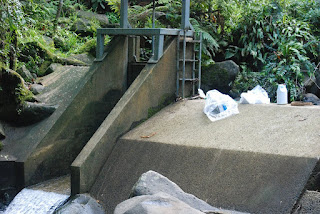























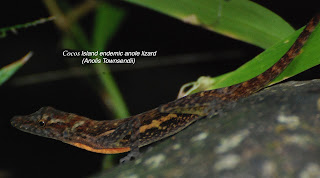











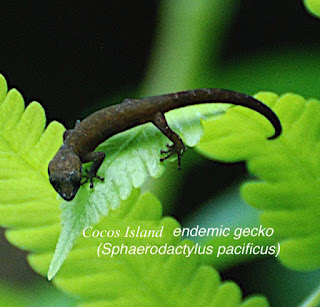

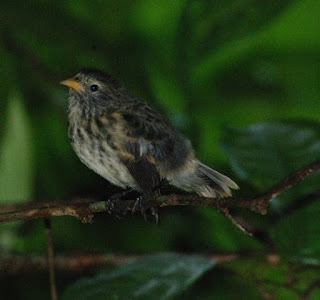








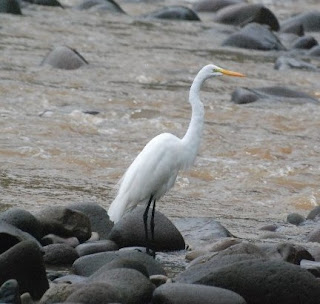




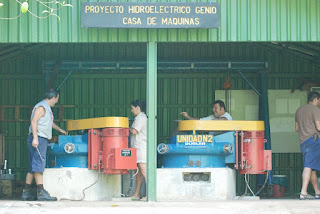
































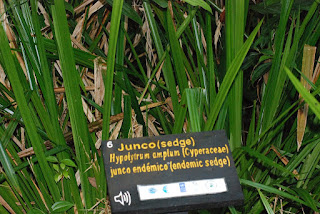






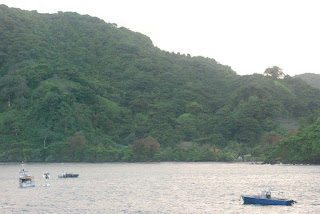








No comments:
Post a Comment